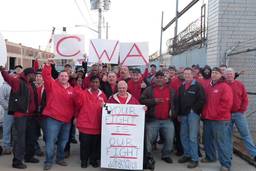For the first time in my journalism career, during one week I wrote four stories about workers winning tough fights. The victories include GE and Cablevision workers unionizing after several failed organizing attempts, the end of the bloody Longview Port longshoremen dispute and the State Department issuing new rules governing student guest workers after last summer’s strike by young Hershey foreign workers.
This extraordinarily rare string of victories leads me to believe that despite major attacks on workers’ organizing and collective bargaining rights, unions can take advantage of workers’ backlash against these attacks and win big victories. They can still organize.
This is not to say the tide is turning for labor because of the overreach of anti-union forces. During the same period of these small but significant victories for workers, others suffered a number of large defeats. Indiana passed right-to-work legislation aimed at gutting the power of private-sector unions, and Senate Democrats passed a bill rolling back the organizing rights of airline and rail workers.
But the key lesson of these these small victories is this: When workers develop individual strategies for their own workplace — rather than rely on gran master plans from union leaders — they’re more likely to win. It’s to study the GE, Cablevision and the the longshoremen union (ILWU) campaign in Longview to understand what works.
In one of the smartest union campaigns I have ever covered, the Communication Workers of America organized 282 Cablevision workers in Brooklyn that had been trying to organize into a union for 13 years. CWA first built a strong shop floor committee to build solidarity in the workplace before even attempting to file for an election.
Then CWA employed the support of prominent Democratic politicians to make statements against the intimidation these workers were experiencing as they attempted to unionize. The result was that Cablevision couldn’t stymie the organizing drive by firing workers, and workers voted 3-to-1 to join CWA.
Not only did CWA win the Cablevision union election, but it inspired another a group of 120 nonunion Cablevision contractors to go out on a wildcat strike in Bronx demanding union recognition and the restoration of a 30-percent wage cut proposed by the company. (See my story here).
After a bitter seven-month struggle that sometimes involved breaking the law, the International Longshoreman and Warehouse Union (ILWU) was able to prevent port company EGT from opening the first terminal on the West Coast not to be represented by the union. On one occasion last July, more than 100 union members were arrested for breaking down a fence and invading the grain terminal in an effort to shut it down. On other occasions, hundreds of ILWU members confronted baton-twirling riot police as they attempt to blocked railroad tracks to prevent goods from moving; workers at ports in Vancouver and Tacoma went on wildcat strikes to show solidarity with the Longshoremen. On another occasion unionists vandalized trains carrying grain to the port. Throughout the confrontations, more than 125 protesters were arrested.
Union leaders, of course, rarely encourage union members to vandalize property and break the law. Workers in Longview decided that that’s what they wanted to do. Ultimately, the prospect of more confrontations between the company, police and union members prompted Washington Governor Christina Gregroie to finally push the company to settle.
Also earlier this month, I covered how GE workers in Kansas City won an organizing drive by a margin of 44-41. The workers at a small service plant in Kansas City had attempted to organize three times before; finally on the fourth time, pro-union workers won an election.
The organizing success was the result of older pro-union workers on the first shift who were willing to stay late into the night after their last shift to talk to younger workers, as well other unionized GE workers from different plants visiting to talk to workers about joining a union. There was no big master plan in the GE organizing victory. The organizing success was the result of rank-and-file worker action.
Likewise, last year I covered how cultural exchange guest workers at one of Hershey’s warehouses in Pennsylvania decided to strike by themselves after receiving only $20-40 a week (after housing and other costs were deducted from their paychecks). They reached out to the local labor community to support them, but the plan to strike came from workers themselves.
The action was wildly successful receiving widespread media attention. It ultimately caused the State Department to announce it will review all policies regulating the J-1 student guest visa program, and will limit the type of work that nearly 350,000 “cultural exchange” workers who enter this country annually are allowed to do. (The State Department also debarred guest worker recruiter Council for Educational Travel from the J-1 program; CETUSA had provided the students to Hershey.)
People inside of America’s labor movement are always searching for the big solution of how to organize lots of workers quickly, or win fights quickly through a grand leverage scheme designed to force employers to agree to voluntary union recognition through card check neutrality, rather than hard-fought NLRB union elections.
A few years ago, I traveled to Boston to cover an attempt by top SEIU strategist Stephen Lerner to organize bank workers at Santander, a foreign-owned company. The organizing committee meeting I attended had nearly twice as many union organizers and community allies in the room as actual bank workers. It was clear that the campaign to organize Santander workers was driven mainly by SEIU staffers, not by workers. The campaign collapsed, and is now largely forgotten.
“Organizing right now is characterized by great ideas, fancy power points, one-year investment and then moving on to grand scheme. It works for professional organizers, but it doesn’t work for actually organizing workers,” ILWU Organizing Director Peter Olney told me earlier this year. “The fundamental moving force in any labor struggle has to be the workers. [But] the art of listening to workers and analyzing their power is gone in the labor movement today.”
All too often I see unions announce huge organizing drives that intend to organize a whole group of workers. A plethora of press releases are released, millions of dollars are committed to organizing an industry, even before the union has organized committees of workers in the industry. Whether it’s SEIU’s bank industry plan or UAW’s strategy to organize foreign-owned auto plants in the right-to-work South, it seems that union leaders often have big strategies to win huge gains — but rarely are those strategies crafted by the workers unions seek to organize. Often, these campaigns involve getting an employer not to intimidate workers instead of working to help people overcome anti-union intimidation campaigns. As UAW President Bob King recently told Reuters about how the struggling union will organize southern plants: “It really is ultimately up to the companies.”
But perhaps the best way to make large gains is to focus on a lot of small workplaces where workers really want to organize. These victories show that the key to success is giving them the skills to organize, and sticking with the organizing campaign of workers, whether it takes four years like it did with the GE shop in Kansas City, or 13 years like it did with Cablevision workers in New York City.
“I think there is a lot of truth in that model of moving slowly forward. You play small ball and all of a sudden that starts adding up to a lot of workers,” says CWA District 1 Organizing Director Tim Dubnau.
The truth is — and it’s a tough one for labor leaders to accept — is that there is no real strategy to rebuild the labor movement other than to support workers to the max in their attempts to organize – however small or unsexy they are. If we are going to rebuild this labor movement, workers are going to have to do it themselves.
Full disclosure: UAW is an In These Times sponsor.








